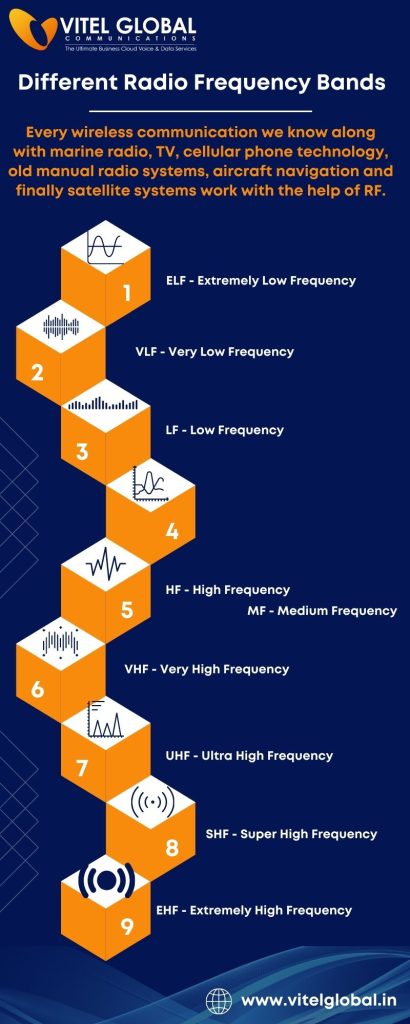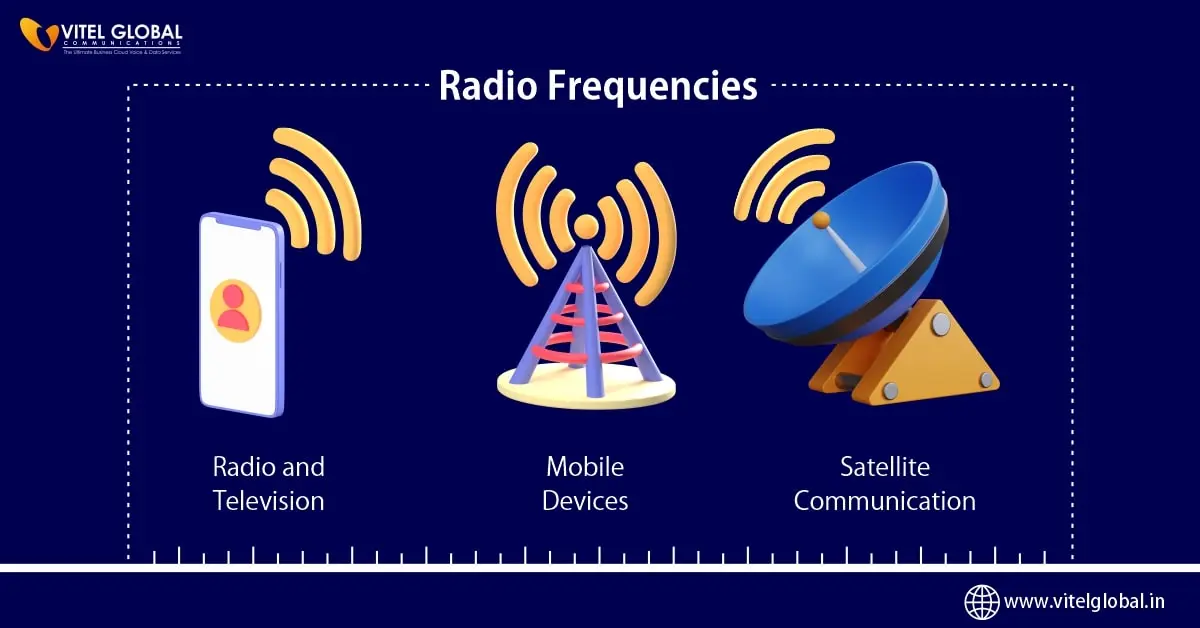Table of Contents
Radio Frequency – Definition:
Radio frequency was best used in the 90’s and it is useful to calculate the rate of change of the oscillation of the electromagnetic spectrum. RF is a wireless means of communication and broadcasting. With an upper limit and lower limit being 300 GHz and 9 kHz, RF uses transmitters and receivers of various types to calculate and process.
Unit of Measurement and Radiation:
The radio frequency is measured in Hertz (Hz [Unit of measurement]) and it informs us about the number of wave cycles transmitted in one second. RF waves are invisible to the human eye. It has a particular spectrum and if the frequency of the wave is increased more than the intended limit of the spectrum, the electromagnetic spectrum might alter its form.
Thus, if the frequency of the RF spectrum goes beyond its upper limit, the electromagnetic rays emerge in the form of Infrared radiation, Gamma rays, X-Rays, and UV Rays most of which are visible to human eyes.
Frequency and Wavelength Relation:
What is Wavelength?
Not every wave is similar and they are generally made in a form which has crests and troughs or compressions and rarefaction. Radiofrequency waves travel in a form that consists of an alternate arrangement of Crests and Troughs.
Wavelength is the distance between 2 crests or 2 troughs.
Wavelength and Frequency Proportionality:
In most of the spectrums, Frequency is inversely proportional to wavelength. It means, that if the frequency of the wave increases, the wavelength of the wave decreases and vice versa.
RF Applications:
The usage of Radio Frequency is implemented in a wide variety of industries. RF predominantly is a wireless form. Therefore, it is used in cordless and cellular phones, radio, and Television. This is to inform you that Wi-Fi and Bluetooth are also based on RF technology.
Besides, TV remotes, and Bluetooth accessories for computers and mobile phones, microwave ovens also operate with shorter IR frequencies.
Different Radio Frequency Bands:
As already informed, the frequency of the Radio wave can dictate the wavelength and the reach of the wave.
For example, every wireless communication we know along with marine radio, TV, cellular phone technology, old manual radio systems, aircraft navigation, and finally satellite systems work with the help of RF.
Here is the list with a short description of various types of Radio waves, their range, and their application.

ELF – Extremely Low Frequency:
These waves have an extremely low frequency ranging from 3 Hz to 3 kHz. Yet, climatic changes can easily affect them. Scientists use these waves to study the earth’s atmosphere.
VLF – Very Low Frequency:
The frequency range of the VLF ways is slightly more than ELF ranging from 3 kHz to 30 kHz with wavelengths of 100 km to 10 km. Due to its low frequency, it is not easy to design the transmitter system. VLFs are commonly used in submarines.
LF – Low Frequency:
Its frequency range is from 30 kHz to 300 kHz and consists of a wavelength from 10 km to 1 km, these are called ground waves. These suit well for long-distance communication. In addition, LF is the most reliable form of communication in times of natural disasters.
MF – Medium Frequency:
This is the most popular frequency band ranging from 300 kHz to 3 MHz. The transmitter system is relatively easier than the above frequencies and it suits Navigation for ships and aircraft, coast guards, and other scientific experiments.
HF – Frequency:
Due to its high frequency and shorter wavelength, it is called a short wave. These waves can reflect from Earth’s Ionosphere and that’s why they suit for long-distance communication. High-Frequency radio waves work for Government systems and weather broadcasting stations.
VHF – Very High Frequency:
VHF operates between 30 MHZ and 300 MHz and is used in analog televisions. Please keep in mind that frequency modulation from 88 MHz to 108 MHz works in the VHF band.
UHF – Ultra High Frequency:
The band limiting from 300 MHz to 3 Hz, and UHF allows all modern wireless communications. But, it is not easy to design and run the frequency system. You generally find this in the usage of Wi-Fi, Bluetooth, CDMA, and GSM technologies.
SHF – Super High Frequency:
In the modern days, SHF is feasible for one on one communication, satellite, and TV as any small hurdle can easily break the line. Even DTH services, mobile, GPS, and microwave ovens run on SHF.
Its frequency ranges from 3 GHz to 30 GHz.
EHF – Extremely High Frequency:
This is the highest frequency available in the radio frequencies. Limiting from 30 GHz to 300 GHz, Extreme High Frequency is good for advanced communication systems since its nature implies its usage. The current 5G technology is based on EHF for its large bandwidth. In addition, people use this in complex operations such as radio astronomy and weather analysis.
Conclusion:
In the present days, after the digitization of the world, every type of technology integrates with each other for more feasible applications. Hence you can find the usage of radio frequency in today’s businesses too.
Grow your business and 𝒎𝒂𝒙𝒊𝒎𝒊𝒛𝒆 the 𝒑𝒓𝒐𝒅𝒖𝒄𝒕𝒊𝒗𝒊𝒕𝒚 with the industry’s best business communication service.
For more details, visit our website and start creating wonders in your organization right away.
For More Info or Book, Your Free Demo Today click here.







